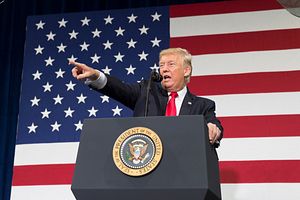After four months of negotiation and tit-for-tat threats, Trump’s trade war on China finally broke out on July 7, when a 25 percent tariff began to be levied on $34 billion worth of Chinese goods. But the story does not stop here. The U.S. administration has threatened another $200 billion worth of Chinese imports with a 10 percent tariff.
On the surface, the trade war was directly initiated with a U.S. Trade Representative (USTR) investigation into China’s theft of U.S. companies’ intellectual property. However, a deeper examination reveals a much more complex picture. As early as January of 2018, when the IP theft problem had not fully come to the media’s attention, the Trump administration imposed a 30 percent tariff on imported solar panels, which were mostly made in China. In February, the U.S. Commerce Department initiated investigations on pipe fittings imported from China and anti-dumping duties went into effect. Two weeks later, China’s aluminum foil faced the same fate. These measures eventually led to Trump’s biggest tariff declaration in March. Since then, tension between the world’s two largest economies has escalated, leading up to the start of the trade war in July.
While some observers have dismissed Trump’s trade war as “insane” or “crazy,” it’s important to look beyond such simple characterizations and consider why Trump launched a trade war targeting China at this moment.
First, the context. Historically, the United States has used Section 301 against China five times previously. Each time, the investigation led to a trade dispute, but all five earlier disputes were eventually resolved without resorting to a trade war. Meanwhile, the trade deficit between the United States and China has existed for very long time. What’s more, the trade deficit between the two countries might not be as huge as some claim. According to Oxford Economics, the overall U.S. trade balance with China, as a share of GDP, has remained relatively stable since 2009.
If the trade deficit is not the central issue in the dispute, then what is really driving the trade war? One true target could be China’s high-tech industries, to be more specific, industries identified by China’s “Made in China 2025 Initiative.” This national strategy aims to build up 10 strategically and technologically important sectors such as 5G networks and cybersecurity, high-end precision tools and robotics, and aerospace. Most of these areas are now exclusive domains of Western companies. But China, by launching a national strategy to advance its domestic high-tech sectors, can be seen as posing a threat to U.S. dominance in these fields. Lorand Laskai, a research assistant at the Council on Foreign Relations, made this clear by writing that the “Made in China 2025” policy is “shaping up to be the central villain, the real existential threat to US technological leadership.”
Second, by launching the trade war, the United States could also be reacting to China’s model of developmental state, which many in the United States see as a threat to the liberal market system. While the Chinese economy is market-driven in numerous ways, many critical components of China’s legacy of planned economy have intentionally been maintained. With this model of developmental state, the Chinese government bolsters lots of industries, including high-tech ones, with subsidies and other types of support. This is widely regarded as a distortion to the market that keeps foreign competitors at a permanent and unfair disadvantage. The trade war, therefore, can be interpreted as an attack on China’s development model.
In order to fully understand the current trade war between the two sides, it’s also critical to put it in the larger context of U.S.-China relations. Ever since China began its rise, the “China threat debate” has persisted, with engagement or containment as the two strategic options for U.S. policy toward China in the 1990s. The Clinton administration took the engagement approach. As former President Bill Clinton once explained, to engage China can push it to “accelerate its internal reforms and propel it toward acceptance of the rule of law.” After China gained WTO membership in 2000, Clinton further claimed China “is agreeing to import one of democracy’s most cherished values: economic freedom.”
However, after decades of engagement, China has not reached the level of economic and political liberalization many had expected. All the while, it has become the second largest economy in the world, thus fueling the China threat perception. Against this backdrop, the trade war can be viewed as a paradigm shift of Washington’s China policy. Along with other recent developments in U.S. policy, such as the Taiwan Travel Act passed in February and the passage of U.S. Navy warships through the Taiwan Strait, the trade war is, in effect, part of a much larger strategy of hedging.
Once we realize that the trade war is not merely about trade, we can then appreciate the very real potential for large-scale conflict between the United States and China. With an understanding of the true causes and depth of the tensions, political elites and policymakers of both countries must approach the current situation cautiously and strategically.
LIU Wei, Ph.D., is an Associate Professor at the School of Public Administration and Policy, Renmin University, China.

































